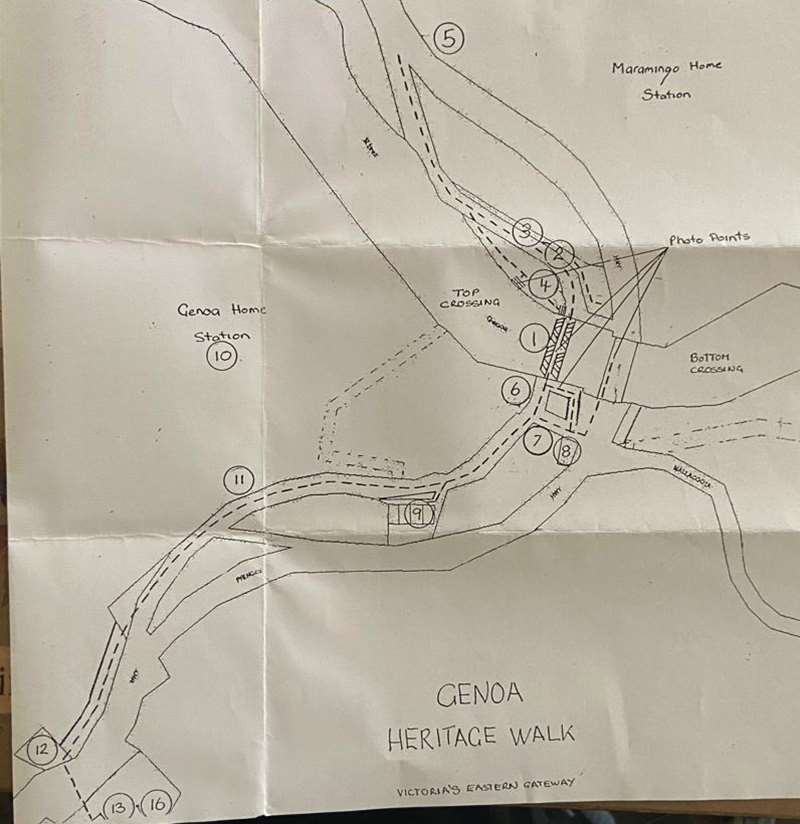Genoa Heritage Walk

1 Genoa Heritage Bridge The first bridge over the Genoa River was constructed with wooden pylons and opened in 1916. Unfortunately this was washed away by the 1919 flood. However it was re-built, some 2 meters higher than the first and this time with concrete pylons. It was re-opened in 1926. Genoa also had two other river crossing points. The first was 100m north of the Heritage Bridge and used prior to bridge construction. The other was a low level bridge 100m south of the New Bridge System which served between c1919-1926 whilst the now Heritage Bridge was being rebuilt. It is interesting that the river frontage served as the roadway leading up to, and away from the original 1916 bridge and both of those crossings.
2 Avenue of Poplars was planted by the Genoa School children (3112) in 1929 as an Arbour Day activity. The school was at that time housed in the old Genoa hall.
3 The Border Fruit Fly Block operated for over 25 years. From about 1945 Queensland fruit fly gradually spread from the NSW coastal fruit growing areas via infected fruit. It was first found in Mallacoota in 1948. Road blocks were set up to stop any fruit from entering Victoria.
The original inspection point was 100m north on the opposite side of the road and moved to this site c1968. After the closure of the Fruit Fly Block the Genoa Sports Club acquired the office for its club rooms and in 1978 moved it adjacent to the tennis courts where it remains today.
4 Genoa Sports Ground This is part of the land the RCA purchased from John Cameron in 1926 in order to form the road and raised approach to the Heritage Bridge. The Genoa Sports Club has used it as its sports ground since about 1930. In its "heyday," when the local area boasted a much larger population, Gymkhanas, Wood Chops, Cricket and Tennis matches were all held on this ground. In 1974 the then Orbost Shire built the caravan park and hence the cricket pitch was lost. Tennis and family fun days are still enjoyed.
5 Maramingo Station was first used as a cattle run for Peter Imlay of Twofold Bay c1838 and first superintended by Charles Lynot and then Captain John Stevenson. Stevenson eventually acquired Maramingo and gave it to his daughter Amelia and her husband James Allan as a wedding present in 1845. The home Allan built was later to become the Maramingo Hotel which burnt down in 1939. Today it is owned by Mr Ken Bridle.
6 Genoa General Store originally built c1923 by Harry Bridle. The store was also the local post office, bank and bakery. Murray Goulburn purchased and demolished the original building in the late 1960's rebuilt the present structure. The store closed 2001 and the post office transferred the Genoa Hotel.
7 Genoa Hotel This building, was to be a two storey pise structure. But before it could be roofed 19 inches of rain caused the walls to subside in a heap of mud c1919. Undaunted, Fred Buckland removed the mud and started again. Then in 1933 fire destroyed the top storey.
The back section was rebuilt from the demolished Yambulla Hotel. The first licence however c1897 was for the Maramingo Hotel located across the Genoa River. This transferred to Alexander's Boarding House in Bass Street in 1913 before finally being transferred to its present location.
8 Original Genoa Hall / School was built c1927 by the local community. The hall was the hub of entertainment. Boasting many dances. People coming from Wangarabell, Wallagaraugh, Cann River to attend. It was also the local picture theatre. B&W films were shown some afternoons. The Hall was also home to the Genoa State School from 1928 until a new school was finally opened in 1953 at its present site.
9 Alexanders Boarding House and Hotel was built c1870 by young Robert Alexander. In 1913 the Maramingo Hotel licence was purchased from John Cameron. After Alexander's sold out it served as one of four RCA/VIC Roads cottage residences. Today it is owned by Mr John Peisley.
10 Old Genore (Genoa) Home Station was first utilized by William Morris as a heifer paddock for his Nangutta cattle Station c1837. The first stockman's hut was built on this property just below the road about 100m east of the stock yards. Presently the property is owned by Mr Allan Peisley.
11 Peisley's Cream Stand Genoa was home to several dairy farms in its early history. Cream was stored in 10 gallon cans and picked up twice a week by Mc Mullins freight company to be taken to the Orbost Butter Factory. The cream stands had to be semi trailer height so that the cans could be transferred easily by hand. Farmers kept pigs to utilize the waste skim milk. In the late 1960's Murray Goulburn bought the factory and changed it to whole milk. This meant that the Genoa farmers needed to upgrade to stainless steel vats. The cost was prohibitive and so farmers changed over to beef.
12 Genoa State School opened in 1953 and closed in 1990. It reopened in 2004 as an outreach of Mallacoota P-12 College at the conclusion of an intensive V-Cal project .
13 New Genoa Hall was opened in 1991 after 10 years of intensive fund raising by the Genoa the Hall committee. A huge general goods Auction is held every year in March by the Hall committee to raise the necessary funds to maintain this building and grounds.
14 Original RCA Genoa Depot Fuel Pump Originally stood next to no 9 Bass Street. Relocated in 2004 for security reasons.
15 Petrified Wood retrieved from the Genoa River.
16 Caste of the 360 Million year Old Devonian Tetrapod Footprints found in the Genoa Gorge by the late Norman Wakefield. Available by appointment only.
Genoa Heritage Walk Map

Location
Park Road, Genoa 3891 View Map








